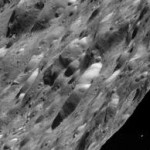In 2004, the Cassini spacecraft equipped with camera and orbiting around Saturn has taken some pictures on Titan’s surface that seems to look like a basin approximately the size of Ontario lake in Canada. That referred basin is now known as Ontario Lacus.
From there on, imaging equipment has been periodically scanning Titan’s terrain during close encounters of the Saturn’s moon. Those scans manifested dark areas that few scientists doubted that they were lakes.
The evaporation that has been discovered in the Southern Hemisphere of the Titan’s lake implies that there are weather and geological recurrence in place similar to those on earth.
On Titan the liquid driving those recurring events happening is not water but methane according to Oded Aharonson, a planetary scientist at the California Institute of Technology.
Like Earth, Titan has been found to accommodate liquid on its surface, that guide planetary scientists and astrobiologists to think that similar organic chemical procedures that led to life on Earth are happening in a glacial greasy compound of hydrocarbons on Titan.
“This is a wonderful opportunity and rare in the solar system to observe a planet with working liquid on its surface, a volatile agent that is responsible for altering its geology and participating in its weather cycle by evaporating and precipitating,” Dr. Aharonson said.
Ontario Lacus, the largest lake in the southern hemisphere of Titan, whose liquid level has receded by nearly five meters over the last four years, causing its shore to fall by more than the nine kilometers in some areas. Other lake levels within the vicinity have also fallen, according to radar measurements made by the Cassini spacecraft.
According to Dr.Aharonson, the reason why Titan behaves as it should be , it is because of that rough rule for hydrological systems like Earth or Titan, which has been expecting that moisture would migrate seasonally from one hemisphere to the other, evaporating where it had been summer and precipitating where it had been winter.
Titan’s atmosphere actual activation can be much more complicated according to Dr. Aharonson, heading to long recurring events in which one hemisphere or the other could be wetter or colder.
Due to the variables of Titan’s orbiting around Saturn and Saturn’s orbiting around the sun, Titan seems closer to the sun during its southern summer than in its northern hemisphere.
As a result, southern summers are currently shorter and more intense than their northern counterparts. Dr. Aharonson and his colleagues argued in a recent paper that this could cause liquid to accumulate more in the northern hemisphere than the southern hemisphere, leading to a net migration of methane to the north over the many years of Titan.
That kind of migration has construed why the area covered by lakes in the north is about a hundred times the area of all the lakes in the southern hemisphere
Dr. Aharonson pointed out that the evaporation rate of Ontario Lacus, which is a meter a year, is not sufficient to fill up all the lakes in the north for one season, implying some longer term responses is at work.
The evaporation rate, Dr. Aharonson said also sends a strong message about what the lakes are made of, namely pure methane, as opposed to heavier ethane or some other chemical which is less volatile.


